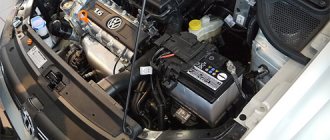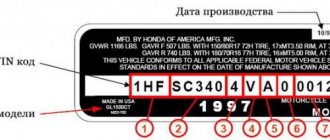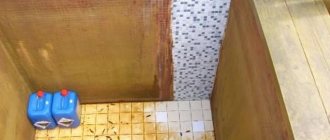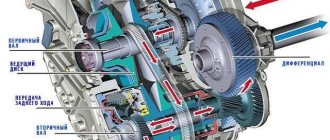Sooner or later, corrosion processes affect any car, becoming the worst enemy of the body. The destruction of the metal occurs due to the reaction of water and oxygen with the components of the alloy. Salts only speed up the whole process. The rate at which rust spreads is also affected by the temperature at which the oxidation reaction occurs; corrosion is especially active in winter.
Anti-corrosion layers on the car body
- Automakers, when releasing a car from the assembly line, provide it with reliable protection against corrosion by applying five layers to the metal:
- Zinc coating is a barrier coating.
- A primer that ensures reliable adhesion of subsequent materials to the metal.
- Acrylic primer is a filler that isolates all possible pores from moisture penetration.
- Car paint. Performs both protective and decorative functions.
- Car varnish.
Exact adherence to the number of layers and their optimal thickness is typical for expensive car models; with cheaper ones, things are a little worse. Many auto repairmen advise carrying out anti-corrosion treatment of the body immediately after purchasing a car.
Body corrosion protection
It is no secret that almost all modern car manufacturers, one way or another, are trying to save on the cost of the bodies of their products. This applies not only to widely available brands of cars, but also to the category of luxury cars. For some reason, manufacturers decided that it was cheaper and easier to make a body from cheap steel than from alloys of non-ferrous metals, and then apply external protection to the body. In this regard, the issue of protecting the body from corrosion is constantly relevant for car owners.
When a car leaves the assembly shop, it is protected only by a primer and a coat of automotive paint. This is quite enough for the first time. But after a short period of time, during operation, the layers of primer and enamel begin to dry out, and as a result, micro cavities form in them. The main disadvantage of conventional car enamels is their inability to absorb onto metal surfaces.
Also, paint cannot create a chemical bond with metal. All this soon causes the formation of small bubbles between the body and the enamel layer. Then water and various chemically aggressive substances penetrate into these bubbles through microcracks. Once there, these reagents begin their destructive activity for the metal, and this inevitably leads to corrosion of the metal. So gradually the car body may even become completely unusable. In this regard, there is a need for additional protective coating of the body.
To successfully combat corrosion, there are special additional coatings made from polymer materials. These coatings may be aerosols, polishing pastes, or other liquids. To apply this coating, you do not have to go to a car service center. Many of these products are available for independent use. But experts strongly recommend that you still contact the service, since many manufacturers of protective coatings make it a mandatory requirement that the body be free from scuffs and scratches.
For this purpose, the intervention of specialists will be required, since polishing the paintwork is a rather complicated process, which is almost impossible to do at home. It will be necessary to use various abrasives, select pastes, grinding materials, etc. If a person without special skills takes on this work, then most likely it will come down to a complete repainting of the car.
How does this protection work? The main thing in the use of polymer coatings is that these coatings create strong chemical bonds with the car enamel layer. This creates an additional invisible layer of coating that firmly preserves the layers of car paint and primer. Polymers fill all microcracks and capillaries in the paint layer and, when hardened, completely block the access of water and other chemical compounds to them. Since the polymers used are chemically inert, this protection creates a strong barrier to external influences on the paintwork and metal of the car body.
The use of polymer coatings allows us to solve not only the problem of protecting a car from corrosion. Many such coatings have another remarkable ability - they do not transmit ultraviolet rays. This helps protect the paintwork from fading.
Another advantage of using these coatings is that they give the car a unique mirror-like shine and smooth surface. The body paint appears glossy, which gives the car a presentable and “expensive” look. If we add the improvement of appearance to the function of corrosion protection, then the use of polymer coatings becomes not only necessary, but also very pleasant.
The most vulnerable areas of the body
If it is not possible to completely protect the body without overhauling the car, it is enough to treat the most vulnerable places where water and reagents constantly get in. They are the bottom, wheel arches and sills of the car. The use of high-quality materials will provide reliable protection for 1-2 years.
The first thing to do is to clean the parts and welds from dirt. Washing, drying and removing rust are mandatory conditions. It is most convenient to carry out processing using special compounds and paint in spray cans.
The following are the stages of protection:
- treatment of the bottom with rubber-containing compounds;
- spraying on the welds of the engine compartment, as well as connecting bolts and suspension elements of multi-component aerosols based on wax and resins;
- applying anti-corrosion agents to the sills and wheel arches, as well as installing barrier protection - wheel arch liners, plastic lockers, spoilers.
How to protect your car from rust
Modern realities are such that the car owner is forced to operate his vehicle on roads treated in the winter with various reagents and salt. If we add to this the fact that most drivers in our country are forced to leave their car on the street, where various types of precipitation have a negative impact on the car, it becomes clear that protecting a car from corrosion is an urgent problem for almost every motorist. There is no need to list in detail what negative consequences for the car and its owner are caused by the appearance of rust on the car body. In addition to the cosmetic side of the issue, there is also an economic one, since a car whose body is corroded significantly loses its value.
WHEN CORROSION OCCURS
Corrosion occurs in cases where water with salt dissolved in it gets into those parts of the body that have mechanical damage (chips, cracks) where, under the influence of temperature, a chemical reaction occurs between the water and the metals, resulting in corrosion. Corrosion begins to spread throughout the car especially actively when it undergoes factory corrosion treatment over time. Under these conditions, corrosion primarily affects wheel arches, the bottom of the car, the bottom of doors, and various seams.
HOW TO PROTECT YOUR CAR
Protecting a car from corrosion involves treating the body with Atikor. Anticorrosive will protect the car from the negative effects of sunlight, moisture, chemicals, and bacteria. Measures to protect the car from corrosion are optimally carried out once every two years. You should not delay this, since even on a new car, factory corrosion protection cannot guarantee the protection of the car body. But in general, the older the car, the more susceptible it is to corrosion. This is not only due to a decrease in the degree of factory corrosion protection. During operation, the car body inevitably receives mechanical damage, and as mentioned above, it is in such places that corrosion occurs. In addition to preventive anticorrosive treatment, it is necessary to protect the body from corrosion after various types of repairs and replacement of body elements.
PROCEDURE FOR PROTECTING A CAR FROM CORROSION
The correct procedure for protecting a car from corrosion involves several stages:
- washing the car and then drying it; inspecting the car body for existing corrosion;
- cleaning the body from corrosion and degreasing affected areas;
- treating the body with preparations to protect against corrosion.
It is best if all of the above steps are performed by professionals in a room specially equipped for this. A professional approach will allow you to better protect your car from corrosion, while the corrosion protection procedure does not always achieve the desired effect
- The American Dream remains a reality. Cadillac introduced new crossovers
See all photo news >>
Car painting: aesthetically pleasing and efficient
Scratches, abrasions and chips on the factory paintwork are not only an aesthetic defect, but also a threat of lightning-fast development of corrosion. The metal begins to deteriorate even under a layer of paint, rendering the entire body unusable. It is imperative to eliminate these problems, and as soon as possible.
Local repairs can also be performed in a garage if you stock up on materials and tools. You need to clean the damaged surface from the old layer of paint and rust, and treat it with anti-corrosion compounds. To buy primers in Khabarovsk or any other city, you need two types - primer and filler. They are applied in successive layers. As for painting body parts, you need to choose high-quality metal paint and a spray gun. To prevent the restored area from looking noticeable on the surface, it is most convenient to use computer color selection.
Contact the MarketEm auto supply store - we will help you choose consumables!
The appearance of corrosion and where it occurs
Everyone who went to school knows what corrosion is. Let us remind those who have forgotten that metal corrosion is its oxidation under the influence of oxygen. Since oxygen is contained in both air and water, the metal begins to corrode immediately after contact with these media. Naturally, if any part of the car is exposed to both water and moisture, corrosion occurs more actively.
Body parts most susceptible to corrosion:
- bottom parts;
- wheel arch liners;
- spars;
- threshold (from inside);
- racks; d
- believe – from within and below;
- wheel arches
In addition, we can talk about the hood , trunk , metal under the door seals , gutters .
Rust appears quite quickly in places where the paintwork is damaged for some reason .
DIY cathodic corrosion protection for cars in the garage
For a car that is stored motionless in a garage, organizing an electrochemical barrier with your own hands is very simple. As mentioned above, the machine itself acts as the cathode. The garage building itself can be designated as the anode if it is made of metal. Or it could be a ground loop if the garage is non-metallic, or the car is parked. A metal floor or exposed metal underneath will prevent rust from forming on the underside of the car.
Cathodic corrosion protection for a moving vehicle
Now let's figure out how to protect a moving car from corrosion with your own hands in this way. As in the method described above, the car acts as a cathode. We can use a grounded rubber “tail” or protective electrodes as an anode.
“Tail” is the simplest method of preventing rust. This is a strip of rubber with metallized elements attached. It is mounted on the back of the vehicle in such a way that it hangs down and creates a potential difference between the car and the wet road surface.
As humidity increases, the effectiveness of oxidation protection automatically increases. It receives splashes from under the wheels of the car, which is beneficial for the electrochemical process. An additional advantage of the “tail” is the removal of static voltage. For example, vehicles with flammable cargo even use such a means as metal chains that drag along the road - this removes the static charge, which can cause a spark and cause a fire.
Rubber grounding tail
The use of protective electrodes is suitable for both moving machines and stationary vehicles. To create an effective system, you need to install about 15-20 elements on the car. These are round or square plates ranging in size from 4 to 10 square centimeters. Aluminum, stainless steel, magnetite, graphite, and platinum are suitable for their manufacture. Aluminum and stainless steel deteriorate over time and will need to be replaced every 4 years.
Such elements have the following properties:
- operate within a radius of up to 0.35 m;
- placed only on painted areas of the car;
- attached using epoxy glue or putty;
- cleaning is required before installation;
- the outer side is not covered with any insulating materials;
- it is necessary to isolate the electrodes from the negatively charged car body
Content
- 1 About corrosion. 1.0.1 Chemical.
- 1.0.2 Electrochemical.
- 1.0.3 Mechanical.
- 3.0.1
corrosion protection
Preventing car corrosion is a much simpler procedure than subsequently restoring rust and re-protecting the car from corrosion.
Protecting a car from corrosion can greatly simplify the life of a car enthusiast. After all, when damage appears on the car body, rust begins to rapidly attack the surface. It's not easy to fight her. Therefore, it is necessary to prevent this auto disease prematurely. Protecting the body from rust begins during its manufacture. At the same time, it is necessary to prevent rust throughout the entire operation of the car.











